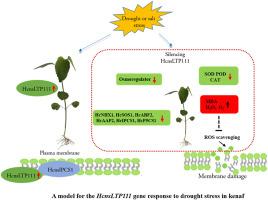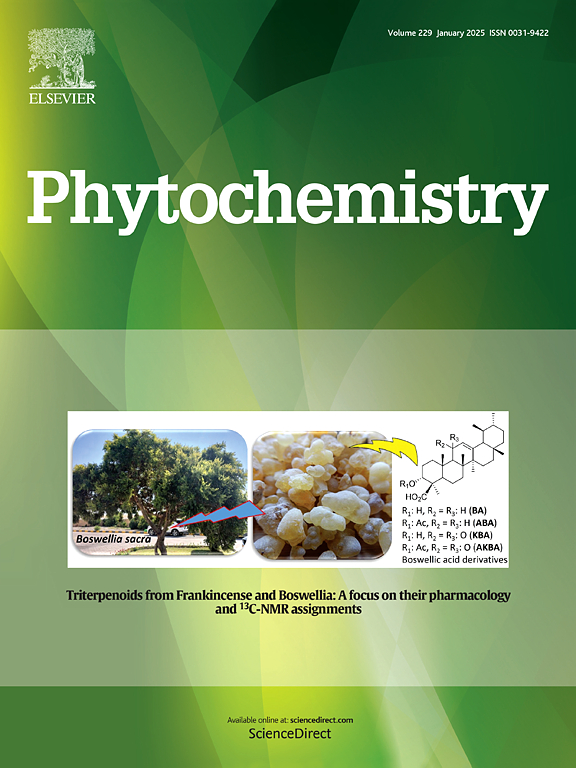非特异性脂质转移蛋白基因HcnsLTP111正调控红麻(Hibiscus cannabinus L.)的耐旱性和盐胁迫性。
IF 3.4
2区 生物学
Q2 BIOCHEMISTRY & MOLECULAR BIOLOGY
引用次数: 0
摘要
红麻(Hibiscus cannabinus L.)是一种重要的韧皮纤维作物,具有较强的非生物抗逆性,在盐碱地和其他边缘土地的利用中具有重要意义。非特异性脂质转移蛋白(nsLTPs)是植物逆境反应的关键调控因子,但其在红麻中的作用及其分子机制尚不清楚。本研究对红麻进行了全基因组分析,鉴定出111个nsLTP基因。所鉴定的基因在18条染色体上分布不均匀,根据系统发育分析被分为9个不同的亚家族。顺式作用元件分析显示,HcnsLTPs启动子富含非生物胁迫响应基序,表明它们在胁迫适应中起着关键作用。干旱和盐胁迫下的表达谱分析表明,HcnsLTP111是一个关键的胁迫诱导基因,其转录和质膜定位显著上调。酵母功能验证表明,HcnsLTP111的异源表达提高了干旱和盐胁迫下的成活率。相反,通过病毒诱导的基因沉默(VIGS)对红麻中HcnsLTP111进行沉默,会导致明显的生长抑制,降低关键抗氧化酶(SOD, POD, CAT)的活性,增加活性氧(ROS)的积累,降低渗透调节化合物的浓度。在沉默系中,ros清除相关基因(HcSOD、HcPOD和HcCAT)和胁迫耐受相关基因(HcNHX1、HcSOS1、HcABF2、HcAAP2、HcIPCS1和HcP5CS1)的表达水平显著降低。此外,通过酵母双杂交(Y2H)和双分子荧光互补(BIFC)分析,揭示了HcnsLTP111和HcIPCS1(胁迫信号通路的关键酶)之间的相互作用。总的来说,HcnsLTP111通过调节活性氧稳态和与应激反应蛋白的相互作用,在红麻耐干旱和耐盐性中起着积极的调节作用。该研究为nsltp介导的胁迫适应提供了新的见解,并确定了HcnsLTP111作为作物改良策略的有前途的候选基因。本文章由计算机程序翻译,如有差异,请以英文原文为准。

A non-specific lipid transfer protein gene HcnsLTP111 positively regulates drought and salt stress tolerance in kenaf (Hibiscus cannabinus L.)
Kenaf (Hibiscus cannabinus L.), an important bast fiber crop with strong abiotic stress tolerance, holds significant significance in the utilization of saline-alkali land and other marginal lands. Non-specific lipid transfer protein (nsLTPs) are key regulators of plant stress responses, yet their roles in kenaf and the underlying molecular mechanisms remain uncharacterized. In this study, a genome-wide analysis was conducted and 111 nsLTP genes were identified in kenaf. The identified genes exhibited an uneven distribution across 18 chromosomes and were grouped into nine distinct subfamilies based on phylogenetic analysis. Cis-acting element analysis revealed that HcnsLTPs promoters are enriched with abiotic stress-responsive motifs, suggesting their pivotal role in stress adaptation. Expression profiling under drought and salt stress identified HcnsLTP111 as a key stress-inducible gene, with significantly upregulated transcription and plasma membrane localization. Functional validation in yeast demonstrated that heterologous expression of HcnsLTP111 enhanced survival rate under drought and salt conditions. Conversely, silencing of HcnsLTP111 in kenaf via virus-induced gene silencing (VIGS) resulted in pronounced growth inhibition, reduced activities of key antioxidant enzymes (SOD, POD, CAT), elevated accumulation of reactive oxygen species (ROS), and diminished concentrations of osmoregulatory compounds. The expression levels of ROS-scavenging related genes (HcSOD, HcPOD, and HcCAT) and stress tolerance-related genes (HcNHX1, HcSOS1, HcABF2, HcAAP2, HcIPCS1, and HcP5CS1) were significantly reduced in the silenced lines. Additionally, the interaction between HcnsLTP111 and HcIPCS1, a key enzyme involved in stress signaling pathways, was shown through yeast two-hybrid (Y2H) assays and bimolecular fluorescence complementation (BIFC) analyses. Collectively, HcnsLTP111 acts as a positive regulator of drought and salt tolerance in kenaf by modulating ROS homeostasis and interacting with stress-response proteins. This study provides novel insights into nsLTP-mediated stress adaptation and identifies HcnsLTP111 as a promising candidate for crop improvement strategies.
求助全文
通过发布文献求助,成功后即可免费获取论文全文。
去求助
来源期刊

Phytochemistry
生物-植物科学
CiteScore
6.40
自引率
7.90%
发文量
443
审稿时长
39 days
期刊介绍:
Phytochemistry is a leading international journal publishing studies of plant chemistry, biochemistry, molecular biology and genetics, structure and bioactivities of phytochemicals, including ''-omics'' and bioinformatics/computational biology approaches. Phytochemistry is a primary source for papers dealing with phytochemicals, especially reports concerning their biosynthesis, regulation, and biological properties both in planta and as bioactive principles. Articles are published online as soon as possible as Articles-in-Press and in 12 volumes per year. Occasional topic-focussed special issues are published composed of papers from invited authors.
 求助内容:
求助内容: 应助结果提醒方式:
应助结果提醒方式:


